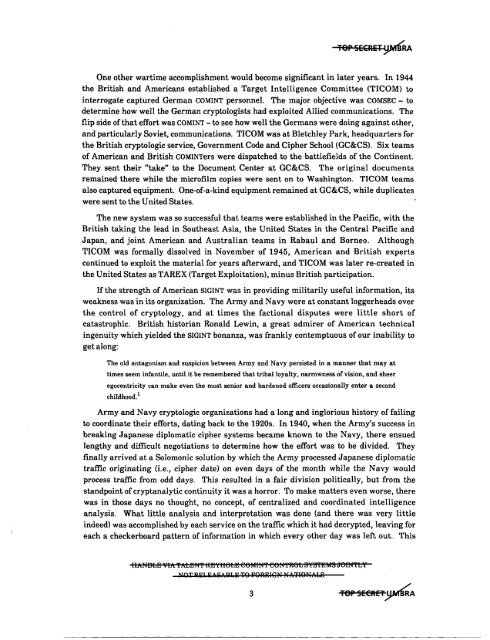American Cryptology during the Cold War - The Black Vault
American Cryptology during the Cold War - The Black Vault
American Cryptology during the Cold War - The Black Vault
You also want an ePaper? Increase the reach of your titles
YUMPU automatically turns print PDFs into web optimized ePapers that Google loves.
Tap SECRET~RA<br />
One o<strong>the</strong>r wartime accomplishment would become significant in later years. In 1944<br />
<strong>the</strong> British and <strong>American</strong>s established a Target Intelligence Committee (TICOM) to<br />
interrogate captured German COMINT personnel. <strong>The</strong> major objective was COMSEC - to<br />
determine how well <strong>the</strong> German cryptologists had exploited Allied communications. <strong>The</strong><br />
flip side of that effort was COMINT - to see how well <strong>the</strong> Germans were doing against o<strong>the</strong>r,<br />
and particularly Soviet, communications. TICOM was at Bletchley Park, headquarters for<br />
<strong>the</strong> British cryptologic service, Government Code and Cipher School (GC&CS). Six teams<br />
of <strong>American</strong> and British COMINTers were dispatched to <strong>the</strong> battlefields of <strong>the</strong> Continent.<br />
<strong>The</strong>y sent <strong>the</strong>ir "take" to <strong>the</strong> Document Center at GC&CS. <strong>The</strong> original documents<br />
remained <strong>the</strong>re while <strong>the</strong> microfilm copies were sent on to Washington. TICOM teams<br />
also captured equipment. One-of-a-kind equipment remained at GC&CS, while duplicates<br />
were sent to <strong>the</strong> United States.<br />
<strong>The</strong> new system was so successful that teams were established in <strong>the</strong> Pacific, with <strong>the</strong><br />
British taking <strong>the</strong> lead in Sou<strong>the</strong>ast Asia, <strong>the</strong> United States in <strong>the</strong> Central Pacific and<br />
Japan, and joint <strong>American</strong> and Australian teams in Rabaul and Borneo. Although<br />
TICOM was formally dissolved in November of 1945, <strong>American</strong> and British experts<br />
continued to exploit <strong>the</strong> material for years afterward, and TICOM was later re-created in<br />
<strong>the</strong> United States as TAREX (Target Exploitation), minus British participation.<br />
If <strong>the</strong> strength of <strong>American</strong> SIGINT was in providing militarily useful information, its<br />
weakness was in its organization. <strong>The</strong> Army and Navy were at constant loggerheads over<br />
<strong>the</strong> control of cryptology, and at times <strong>the</strong> factional disputes were little short of<br />
catastrophic. British historian Ronald Lewin, a great admirer of <strong>American</strong> technical<br />
ingenuity which yielded <strong>the</strong> SIGINT bonanza, was frankly contemptuous ofour inability to<br />
get along:<br />
<strong>The</strong> old antagonism and suspicion between Army and Navy persisted in a manner that may at<br />
times seem infantile, until it be remembered that tribal loyalty, narrowness of vision. and sheer<br />
egocentricity can make even <strong>the</strong> most senior and hardened officers occasionally enter a second<br />
childhood. l<br />
Army and Navy cryptologic organizations had a long and inglorious history of failing<br />
to coordinate <strong>the</strong>ir efforts, dating back to <strong>the</strong> 1920s. In 1940, when <strong>the</strong> Army's success in<br />
breaking Japanese diplomatic cipher systems became known to <strong>the</strong> Navy, <strong>the</strong>re ensued<br />
lengthy and difficult negotiations to determine how <strong>the</strong> effort was to be divided. <strong>The</strong>y<br />
finally arrived at a Solomonic solution by which <strong>the</strong> Army processed Japanese diplomatic<br />
traffic originating (i.e., cipher date) on even days of <strong>the</strong> month while <strong>the</strong> Navy would<br />
process traffic from odd days. This resulted in a fair division politically, but from <strong>the</strong><br />
standpoint ofcryptanalytic continuity it was a horror. To make matters even worse, <strong>the</strong>re<br />
was in those days no thought, no concept, of centralized and coordinated intelligence<br />
analysis. What little analysis and interpretation was done (and <strong>the</strong>re was very little<br />
indeed) was accomplished by each service on <strong>the</strong> traffic which it had decrypted, leaving for<br />
each a checkerboard pattern of information in which every o<strong>the</strong>r day was left out. This<br />
IIltNBbS VIA ¥zItbSfff I(fi]YII6Lfi] e6MHof¥ e6H'fft6L S i S¥fi]MS J6IIof'fL i<br />
NOT RIP Ii: A ~ A IH..Ji: TQ ¥QRJi:lQl'T l'TATIQl'TlzbS<br />
3
















